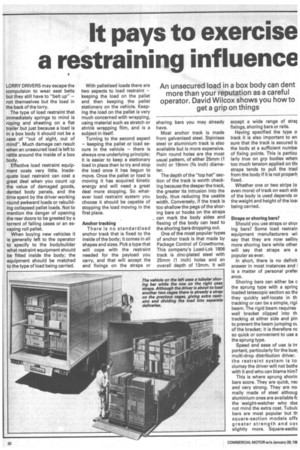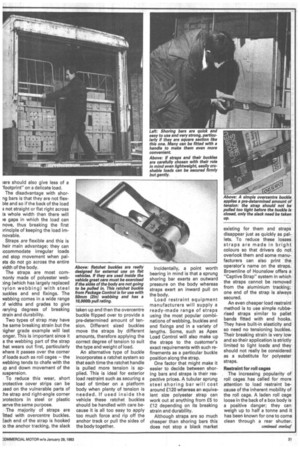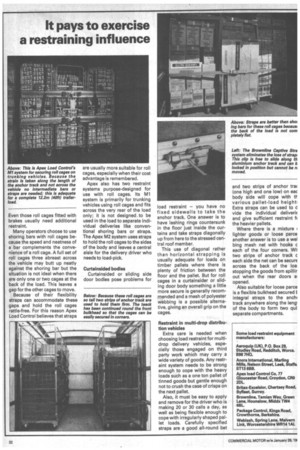• It pays to exercise a restraining influence
Page 32

Page 33

Page 34

If you've noticed an error in this article please click here to report it so we can fix it.
An unsecured load in a box body can dent more than your reputation as a careful operator. David Wilcox shows you how to get a grip on things
LORRY DRIVERS may escape the compulsion to wear seat belts but they still have to "belt up" — not themselves but the load in the back of the lorry.
The type of load restraint that immediately springs to mind is roping and sheeting on a flat trailer but just because a load is in a box body it should not be a case of "out of sight, out of mind". Much damage can result when an unsecured load is left to rattle around the inside of a box body.
Effective load restraint equipment costs very little. Inadequate load restraint can cost a great deal when you count up the value of damaged goods, dented body panels, and the time spent by the driver working round awkward loads or rebuilding collapsed pallet loads. Not to mention the danger of opening the rear doors to be greeted by a torrent of falling cases or an escaping roll pallet.
When buying new vehicles it is generally left to the operator to specify to the bodybuilder what restraint equipment should be fitted inside the body; the equipment should be matched to the type of load being carried. With palletised loads there are two aspects to load restraint — keeping the load on the pallet and then keeping the pallet stationary on the vehicle. Keeping the load on the pallet is very much concerned with wrapping, using material such as stretch or shrink wrapping film, and is a subject in itself.
Turning to the second aspect — keeping the pallet or load secure in the vehicle — there is always one underlying principle; it is easier to keep a stationary load in place then to try and stop the load once it has begun to move. Once the pallet or load is moving it has acquired kinetic energy and will need a great deal more stopping. So whatever load restraint system you choose it should be capable of stopping the load moving in the first place.
Anchor tracking There is no standardised anchor track that is fixed to the inside of the body; it comes in all shapes and sizes. Pick a type that will cope with the restraint needed for the payload you carry, and that will accept the end fixings on the straps or sharing bars you may already have.
Most anchor track is made from galvanised steel. Stainless steel or aluminium track is also available but is more expensive. Plain round holes are the most usual pattern, of either 25mm (1 inch) or 19mm (3/4 inch) diameter.
The depth of the "top hat" section of the track is worth checking because the deeper the track, the greater its intrusion into the body, thus reducing the usable width. Conversely, if the track is too shallow the pegs of the shoring bars or hooks on the straps can mark the body sides and flexing of the body can lead to the shoring bars dropping out.
One of the most popular types of anchor track is that made by Package Control of Crowthorne. This company's Load-Lok 1806 track is zinc-plated steel with 25mm (1 inch) holes and an overall depth of 13mm. It wil accept a wide range of strar fixings, shoring bars or rails.
Having specified the type o track it is also important to en sure that the track is secured tc the body at a sufficient numbe of fixing points. This is particu larly true on grp bodies when too much tension applied on th( straps tends to pull the tracl from the body if it is not proper!) fixed.
Whether one or two strips (o even more) of track on each sick of the body is used depends or the weight and height of the loaf being carried.
Straps or shoring bars?
Should you use straps or shor ing bars? Some load restrain equipment manufacturers wi say that they are now sellinl more shoring bars while other will say that straps are a popular as ever.
In short, there is no definit answer in most instances and ■ is a matter of personal prefer .ence.
Shoring bars can either be c the sprung type with a spring loaded telescopic section so the they quickly self-locate in th tracking or can be a simple, rigi beam. The rigid beam requires wall bracket clipped into th tracking at either side and pin to prevent the beam jumping oi of the bracket; it is therefore nc so quick or convenient to use a the sprung type.
Speed and ease of use is in' portant, particularly for the bus) multi-drop distribution driver. the restraint system is to clumsy the driver will not bottle with it and who can blame him?
This is where sprung shorin bars score. They are quick, nei and very strong. They are no mally made of steel althoug aluminium ones are available fc the weight-watcher who doe not mind the extra cost. TubulE bars are most popular but th square-section models offe greater strength and co: slightly more. Square-sectio
tars should also give less of a 'footprint" on a delicate load. The disadvantage with shorn bars is that they are not flexble and so if the back of the load not straight or flat right across ts whole width then there will ws gaps in which the load can nove, thus breaking the first winciple of keeping the load imnovable.
Straps are flexible and this is heir main advantage; they can iccommodate irregular loads Ind stop movement when palats do not go across the entire vidth of the body.
The straps are most cornnonly made of polyester web)ing (which has largely replaced )ylon webbing) with steel )uckles and end fixings. The webbing comes in a wide range g widths and grades to give farying degrees of breaking drain and durability.
Two types of strap may have he same breaking strain but the ligher grade example will last onger. This is important since it s the webbing part of the strap hat wears out first, particularly where it passes over the corner g loads such as roll cages — the webbing tends to chafe with the ip and down movement of the ;uspension.
To reduce this wear, short Hotective cover strips can be 'sod on the vulnerable parts of he strap and right-angle corner Drotectors in steel or plastic ;erve the same purpose.
The majority of straps are itted with overcentre buckles. Each end of the strap is hooked :o the anchor tracking, the slack taken up and then the overcentre buckle flipped over to provide a pre-determined amount of tension. Different sized buckles move the straps by different amounts, therefore applying the correct degree of tension to suit the type and weight of load.
An alternative type of buckle incorporates a ratchet system so that each time the ratchet handle is pulled more tension is applied. This is ideal for exterior load restraint such as securing a load of timber on a platform body when plenty of tension is needed. If used inside the vehicle these ratchet buckles should be handled with care because it is all too easy to apply too much force and rip off the anchor track or pull the sides of the body together. Incidentally, a point worth bearing in mind is that a sprung shoring bar exerts an outward pressure on the body whereas straps exert an inward pull on the body.
Load restraint equipment manufacturers will supply a ready-made range of straps using the most popular combinations of webbing, buckles and end fixings and in a variety of lengths. Some, such as Apex Load Control will also make up the straps to the customer's exact requirements with such refinements as a particular buckle position along the strap.
One factor that might make it easier to decide between shoring bars and straps is their respective prices. A tubular soiling steel shoring bar will cost around £120 whereas an equivalent size polyester strap can work out at anything from £5 to £12 depending on its breaking strain and durability.
Although straps are so much cheaper than shoring bars this does not stop a black market existing for them and straps disappear just as quickly as pallets. To reduce these losses straps are made in bright colours so that drivers do not overlook them and some manufacturers can also print the operator's name on the straps. Brownline of Hounslow offers a "Captive Strap" system in which the straps cannot be removed from the aluminium tracking; one end of the strap is always secured.
An even cheaper load restraint method is to use simple rubberised straps similar to pallet bands fitted with end hooks. They have built-in elasticity and so need no tensioning buckles. Their breaking strain is very low and so their application is strictly limited to light loads and they should not really be considered as a substitute for polyester straps.
Restraint for roll cages . The increasing popularity of roll cages has called for more attention to load restraint because of the inherent mobility of the roll cage. A laden roll cage loose in the back of a box body is a positive danger; they can weigh up to half a tonne and it has been known for one to come clean through a rear shutter. Even those roll cages fitted with brakes usually need additional restraint.
Many operators choose to use shoring bars with roll cages because the speed and neatness of a bar complements the convenience of a roll cage. A full set of roll cages three abreast across the vehicle may butt up neatly against the shoring bar but the situation is not ideal when there are only one or two cages at the back of the load. This leaves a gap for the other cages to move.
Because of their flexibility straps can accommodate these gaps and hold the roll cages rattle-free. For this reason Apex Load Control believes that straps are usually more suitable for roll cages, especially when their cost advantage is remembered.
Apex also has two restraint systems purpose-designed for use with roll cages. Its M1 system is primarily for trunking vehicles using roll cages and fits across the very rear of the load only; it is not designed to be used in the load to separate individual deliveries like conventional shoring bars or straps. The Apex M2 system uses straps to hold the roll cages to the sides of the body and leaves a central aisle for the delivery driver who needs to load-pick.
Curtainsided bodies Curtainsided or sliding side door bodies pose problems for load restraint — you have no fixed sidewalls to take the anchor track. One answer is to have lashing rings countersunk in the floor just inside the curtains and take straps diagonally up from here to the stressed central roof member.
This use of diagonal rather than horizontal strapping is usually adequate for loads on timber pallets where there is plenty of friction between the floor and the pallet. But for roll cages in a curtainsider or sliding door body something a little more secure is generally recommended and a mesh of polyester webbing is a possible alternative, giving an overall grip on the cages.
Restraint in multi-drop distribu tion vehicles
Extra care is needed when choosing load restraint for multidrop delivery vehicles, especially those engaged on third party work which may carry a wide variety of goods. Any restraint system needs to be strong enough to cope with the heavy loads such as a one ton pallet of tinned goods but gentle enough not to crush the case of crisps on the next pallet.
Also, it must be easy to apply and remove for the driver who is making 20 or 30 calls a day, as well as being flexible enough to cope with irregularly shaped pallet loads. Carefully specified straps are a good all-round bet and two strips of anchor Vac (one high and one low) on eac body side will cope with ti' various pallet-load height: Extra straps can be used to d vide the individual deliverit and give sufficient restraint fi the heavier pallets.
Where there is a mixture lighter goods or loose parce another answer is to use a wel bing mesh net with hooks c each of the four corners. Wi1 two strips of anchor track c each side the net can be securc across the back of the loa, stopping the goods from spillir out when the rear doors al opened.
Also suitable for loose parce is a flexible bulkhead secured t integral straps to the anch( track anywhere along the leng of the body to form two qui separate compartments.




















































































